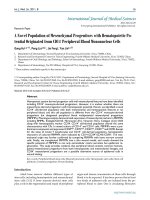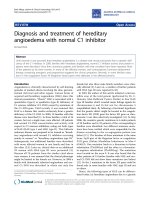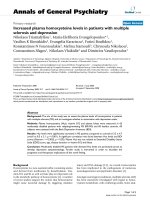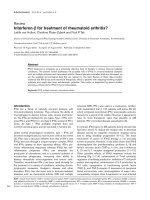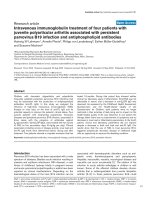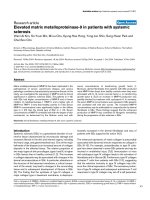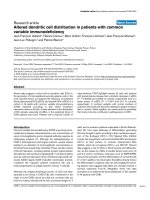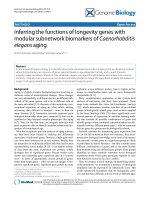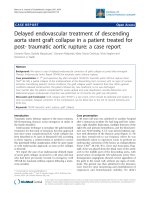Báo cáo y học: "Intravenous immunoglobulin treatment of four patients with juvenile polyarticular arthritis associated with persistent parvovirus B19 infection and antiphospholipid antibodies" pptx
Bạn đang xem bản rút gọn của tài liệu. Xem và tải ngay bản đầy đủ của tài liệu tại đây (61.74 KB, 6 trang )
Introduction
Parvovirus B19 infection has been associated with a wide
spectrum of diseases. Besides acute infection resulting in
anaemia and erythema infectiosum (fifth disease), a rash
illness of childhood, hydrops fetalis in pregnant women
and acute symmetrical polyarthropathy in adults have been
reported as clinical manifestations. Depending on the
haematological status of the host, B19 infection can be
associated with haematopoietic disorders such as anti-
plastic crisis, thrombocytopenia and pancytopenia.
Hepatitis, myocarditis, myositis, neurological disease and
vasculitis can occur occasionally [1]. The relation of the
infection to acute arthritis–arthralgias in children is well
known. Some of the affected children develop chronic
arthritis that is indistinguishable from juvenile idiopathic
arthritis [2–5]. In these patients parvovirus B19 could
ANA = anti-nuclear antibodies; anti-PL IgG = antiphospholipid antibodies; β
2
GPI = β
2
-glycoprotein I; CK = creatine kinase; CRP = C-reactive
protein; ENA = extractable nuclear antigens; ESR = erythrocyte sedimentation rate; IVIG = intravenous immunoglobulin; KINDL = Health-related
Quality of Life Questionnaire for Children; MTX = methotrexate; NSAID = non-steroidal anti-inflammatory drugs; TCHA = triamcinolone hexaace-
tonid; VP1 = viral protein 1; VP2 = viral protein 2.
Available online />Research article
Intravenous immunoglobulin treatment of four patients with
juvenile polyarticular arthritis associated with persistent
parvovirus B19 infection and antiphospholipid antibodies
Hartwig W Lehmann
1
, Annelie Plentz
2
, Philipp von Landenberg
3
, Esther Müller-Godeffroy
4
and Susanne Modrow
2
1
Rheumaklinik Bad Bramstedt, Bad Bramstedt, Germany
2
Institute for Medical Microbiology, Universität Regensburg, Regensburg, Germany
3
Department for Clinical Chemistry and Laboratory Medicine, Universität Mainz, Mainz, Germany
4
Clinic of Pediatrics, Medizinische Universität Lübeck, Lübeck, Germany
Correspondence: Susanne Modrow (e-mail: )
Received: 12 Jun 2003 Revisions requested: 26 Aug 2003 Revisions received: 29 Aug 2003 Accepted: 24 Sep 2003 Published: 10 Oct 2003
Arthritis Res Ther 2004, 6:R1-R6 (DOI 10.1186/ar1011)
© 2004 Lehmann et al., licensee BioMed Central Ltd (Print ISSN 1478-6354; Online ISSN 1478-6362). This is an Open Access article: verbatim
copying and redistribution of this article are permitted in all media for any purpose, provided this notice is preserved along with the article's original
URL.
Abstract
Children with rheumatic oligoarthritis and polyarthritis
frequently establish persistent parvovirus B19 infections that
may be associated with the production of antiphospholipid
antibodies (anti-PL IgG). In this study we analysed the
influence of high-dose intravenous immunoglobulin (IVIG)
therapy on virus load, on the level of anti-PL IgG and its
potential capacity to improve the patients’ clinical status. Four
juvenile patients with long-lasting polyarticular rheumatic
diseases and persistent parvovirus B19 infection, associated in
three cases with the presence of antibodies against
β
2
-glycoprotein I (anti-β
2
GPI IgG), were treated with two cycles
of IVIG on five successive days (0.4 g/kg per day). Clinical
parameters including scores of disease activity, virus load and
anti-PL IgG levels were determined before, during and after
treatment. Two patients showed a complete remission that has
lasted 15 months. During that period they showed neither
clinical nor laboratory signs of inflammation. Viral DNA was not
detectable in serum, and a decrease in anti-β
2
GPI IgG was
observed. As assessed by the Childhood Health Assessment
Questionnaire and the Health-related Quality of Life
Questionnaire for Children, both patients were no longer
restricted in their activities of daily living and no impact on the
health-related quality of life was observed. In one patient the
therapy failed: there was no improvement of symptoms and no
decrease in virus load or inflammatory parameters. In the fourth
patient, clinical and laboratory parameters did not improve
despite a decrease in both viral load and anti-PL IgG. Our
results show that the use of IVIG to treat parvovirus B19-
triggered polyarticular rheumatic disease of childhood might
offer an opportunity to improve this disabling condition.
Keywords: antiphospholipid antibodies, immunoglobulin therapy, juvenile arthritis, parvovirus B19, persistent infection
Open Access
R1
R2
Arthritis Research & Therapy Vol 6 No 1 Lehmann et al.
frequently be detected in synovial fluid and serum
samples. In some of the affected children the infection
persisted over months and years. Furthermore we recently
reported that in these children persistent parvovirus B19
infection was frequently associated with the presence of
antiphospholipid antibodies (anti-PL IgG) [6].
During the past decade the treatment of various sequelae
of chronic parvovirus B19 infection with high-dose intra-
venous immunoglobulin (IVIG) has emerged as a powerful
tool to improve patient status or to cure the disease. In
most instances, immunosuppressed patients or patients
with haematopoietic disorders have been treated [1].
Solid organs (such as kidney) have also been shown to
become infected by parvovirus B19 and to respond to
immunoglobulin treatment [7]. Stahl and colleagues
reported a marked improvement after IVIG treatment in
two of three young patients with oligoarthritis and persis-
tent infection with parvovirus B19 [8]. Here we show the
results after treatment of four adolescents having different
polyarticular rheumatic diseases triggered by parvovirus
B19.
Materials and methods
Patients
For IVIG treatment we selected four patients with juvenile
idiopathic arthritis that had lasted for between 23 and
125 months and persistent B19 infection. Patients were
classified according to International League of Associa-
tions for Rheumatology criteria (Table 1).
Patient 1, a 12-year-old HLA-B27-negative girl, had
rheumatoid-factor-positive polyarthritis (negative for anti-
nuclear antibodies [ANA] and double-stranded DNA). Par-
vovirus B19-specific IgG and IgM antibodies were initially
detected 4 months after the onset of symptoms and
remained detectable during the whole observation time. At
the beginning of the disease the cervical spine, one ankle
and one metacarpophalangeal I joint were affected. Treat-
ment was established with methotrexate (MTX) (subcuta-
neous, 12 mg/m
2
body surface per week) in combination
with an intravenous prednisolone pulse. Despite a thera-
peutic regimen with combined applications of non-
steroidal anti-inflammatory drugs (NSAID), MTX and oral
prednisolone, multiple relapses occurred in small and
Table 1
Laboratory and clinical parameters of the patients before IVIG therapy
Disease IgG antibodies IgM antibodies B19 DNA
†
Anti-PL IgG
(ILAR Disease Joint
Patient criteria) duration
*
erosion Treatment VP1/VP2 NS1 VP1/VP2 NS1 Serum SF Anti-CL Anti-PS Anti-β
2
GPI
1 RF-positive 23 + NSAID ++ – ++ – 10
3
10
2
––++
polyarthritis MTX
TCHA
Prednisolone
(iv/oral)
2 Psoriatic 96 + NSAID ++ + + – 4 ×10
3
3×10
2
––+
arthritis MTX
TCHA
3 Psoriatic 48 – NSAID ++ + – – 2 ×10
3
6×10
3
–––
arthritis MTX
TCHA
Prednisone
4 Reactive 125 – NSAID ++ – – – 6×10
2
10
3
––++
arthritis Choroquine
Prednisone
Sulphasalazine
*
Months before IVIG therapy.
†
Genome equivalents per ml of sample. Anti-β
2
GPI, anti-β
2
-glycoprotein I; anti-CL, anti-cardiolipin; anti-PL IgG;
antiphospholipid antibodies; anti-PS, anti-phosphatidylserine; ILAR, International League of Associations for Rheumatology; iv, intravenous; IVIG,
high-dose intravenous immunoglobulin; MTX, methotrexate; NS1, nonstructural protein 1; NSAID, nonsteroidal anti-inflammatory drugs;
RF, rheumatoid factor; SF, synovial fluid; TCHA, intra-articularly injected crystalline glucosteroids; VP1, viral protein 1; VP2, viral protein 2.
R3
large joints. First erosions (signal cysts) were seen. Multi-
ple treatments with arthrocentesis and intra-articularly
injected crystalline glucocorticosteroids (triamcinolone
hexaacetonid; TCHA) were performed. B19 DNA was
repeatedly amplified from synovial fluid and serum
samples and anti-β
2
GPI IgGs were detected (Table 1).
Patient 2, an HLA-B27-positive 17-year-old girl, had psori-
atic arthritis with daktylitis and multiple psoriatic efflores-
cences. Disease started at the age of 9 years and activity
was mild. After 7 years, mutilations of metatarsopha-
langeal V and erosions of metatarsophalangeal IV and
metacarpophalangeal II joints were observed by X-ray. Fre-
quent relapses occurred subsequently, requiring subcuta-
neous MTX (up to 20 mg/week), NSAID and multiple
TCHA injections into small and large joints. X-ray examina-
tions showed slow progression of the erosions. IgG
against parvovirus B19 proteins VP1 and VP2, low titres
of VP2-specific IgM and viral genomes were detected
during the first serological screening performed at the age
of 16 years. IgM antibodies and parvovirus DNA remained
detectable, together with anti-β
2
GPI IgG in subsequent
serum and in all synovial fluid samples (Table 1).
Patient 3, an HLA-B27-negative 16-year-old boy, had psori-
atic arthritis with psoriatic efflorescences at the scalp, start-
ing with recurrent monoarthritis of the right knee at the age
of 12 years. The patient was treated with low-dose pred-
nisolone and repeated arthrocentesis of the knee. After a
relapse affecting the right knee and the wrist, oral MTX was
prescribed. During a relapse of the wrist and arthritis of the
left elbow, both joints were treated with TCHA. Despite a
weekly administration of 20 mg of subcutaneous MTX, he
developed massive effusions of multiple large joints requir-
ing TCHA. Parvovirus B19 DNA was detected in four dif-
ferent synovial fluid samples from the right knee, both hips
and the left elbow, and in two serum samples obtained
during the 6 months before the study (Table 1).
Patient 4, a 12-year-old girl, developed an effusion of the
right knee at the age of 21 months. Because of the transi-
tory presence of B19-specific IgM antibodies, parvovirus-
associated reactive arthritis was diagnosed. Initially the
patient was treated with NSAID, low-dose prednisone and
chloroquine, which was subsequently replaced by sul-
phasalazine. Despite this treatment regimen the patient
developed recurrent arthritis of both knees requiring multi-
ple TCHA treatment, and arthroscopic synovectomy of the
right knee was performed. After a long-lasting remission
period NSAID treatment was stopped. Subsequently
relapses of both knees occurred. At this time point, nearly
10 years after the initial detection of parvovirus B19-spe-
cific IgM, anti-β
2
GPI IgG was detected and B19 DNA was
amplified from serum. During a further flare (4 months
before the study), B19 DNA was found in serum and in
the synovial fluid of the left knee. The IVIG treatment was
started after a relapse occurred in the left knee, both
ankles and the calcaneo-cuboid and talo-navicular joints.
Treatment regimen and monitoring of the patients
IVIG (commercially available immunoglobulin preparations
previously shown to contain large amounts of IgG against
the viral capsid proteins VP1 and VP2 and to be free of
contaminating B19 DNA; Varitect CP; Biotest, Dreieich,
Germany) were administered at 0.4 g/kg body weight per
day for 5 days. A second cycle of treatment was applied
4 weeks after the end of the first cycle. Patients were
examined before each treatment cycle, 1 and 9 months
after the end of the second cycle and subsequently at
intervals of 3 months. Erythrocyte sedimentation rate
(ESR), complete blood count, C-reactive protein (CRP),
alkaline phosphatase, transaminases and γ-glutamyltrans-
ferase, creatine kinase, lactate dihydrokinase, protein elec-
trophoresis, urinalysis, ANA, extractable nuclear antigens
(ENA) and rheumatoid factor were determined. To exclude
other infections with arthritis-associated infectious agents,
various antibody titres were determined (for example Borre-
lia, Yersinia, Campylobacter, Chlamydia, Salmonella and
streptolysin O). To estimate the clinical course, the number
of affected joints was counted at each presentation. The
affected joints were classified as active arthritis according
to the American Rheumatism Association criteria.
Detection of B19-specific antibodies,
immunocomplexes, genomes and anti-PL IgG
Patient samples were analysed for IgG and IgM against
the structural and non-structural proteins of parvovirus
B19 by Western blotting and ELISA assays (RecomBlot
and RecomWell; Mikrogen GmbH, Munich, Germany).
The total IgG content of these samples was determined by
nephelometry. The amounts of immunocomplexed virus, of
B19 DNA and of anti-PL IgG were determined as
described [3,6].
Global assessment and disease impact on activities of
daily living
In addition to the doctor’s global assessment, both parent’s
global assessments were recorded on a visual analogue
scale ranging from 0 (healthy) to 10 (severely affected).
Restrictions in activities of daily living and the impact on
the health-related quality of life were estimated by using
the Childhood Health Assessment Questionnaire and the
Health-related Quality of Life Questionnaire for Children
(KINDL) as described [2]. Informed consent was obtained
from the parents as well as from the patients.
Results
Apart from elevated inflammatory parameters, no gross
abnormalities in the routine laboratory analysis were seen,
except elevated concentrations of total IgG at the ends of
both treatment cycles and 4 weeks after the second cycle
in all patients. VP1-specific and VP2-specific reactions
Available online />were obtained in all samples diluted 1:10
5
to 1:10
6
. A
slight anaemia and an elevated creatine kinase (CK) was
observed in patient 2. ANA were not detected in patients
1, 2 and 3. Patient 4 showed a titre of 1:1600 in all
samples. ENA were not detectable (Table 2).
Patient 1 responded well to IVIG treatment. At the end of
the cycles, viral genomes could not be detected and anti-
PL IgG declined. X-ray examinations showed regression of
the erosions. Oral steroid and NSAID therapy were gradu-
ally decreased to zero. MTX application was continued.
During a post-treatment observation period of 15 months,
no relapse occurred and the patient was free from disease
(visual analogue scale = 1; Table 2). The disability index
decreased from 0.13 to 0. The health-related quality of life
increased from 75 to 83.3.
Patient 2 did not benefit from IVIG, although the elevated
CK (103 U/l) normalized during the first treatment cycle
and the number of joints affected with arthritis was
reduced from four to two. The elevated ESR and CRP
increased slightly. Virus load and the level of anti-PL IgG
Arthritis Research & Therapy Vol 6 No 1 Lehmann et al.
R4
Table 2
Laboratory and clinical parameters of the patients during IVIG therapy
Total B19 DNA IgG anti-PL
ESR WBC/ RBC/ Hb CRP CK Arthritis IgG VAS VAS
Patient Sample (mm/h) ml ml (g/dl) (mg/dl) (U/l) (joints) (mg/dl) Serum SF Anti-CL Anti-PS Anti-β
2
GPI (doctor) (parents)
1 1 5 7.96 4.21 12.0 neg. 15 2 414 pos. na – – ++ 5 3
2 nd nd nd nd nd nd nd 1832 neg. na – – + nd nd
3 5 6.88 4.25 12.3 neg. 21 0 1430 pos. na – – – 1 1
4 nd nd nd nd nd nd nd 2480 neg. na – – – nd nd
5 9 9.58 4.36 12.3 neg. 16 0 1406 neg. na – – (+) 1 1
6 9 7.0 4.4 12.2 neg. 17 0 nd neg. na – – – 1 1
2 1 35 8.57 4.82 11.5 0.7 103 4 1450 neg. na – – + 4 4
2 nd nd nd nd nd nd nd 3040 neg. na – – + n.d nd
3 37 7.47 4.43 11.3 2.6 33 1 468 neg. na – – – 5 6
3 nd nd nd nd nd nd nd 3680 neg. na + ++ ++ nd nd
5 40 6.18 4.47 11.6 1.5 30 2 2020 pos. na – – – 4 6
6 42 7.91 4.63 11.7 6.4 27 2 nd neg. na – – – 5 7
3 1 15 6.33 4.84 13.5 0.5 20 0 864 pos. na – – – 5 5
2 nd nd nd nd nd nd nd 3600 pos. na – – – nd nd
3 12 6.96 4.61 13.1 0.7 25 0 1604 pos. na – – – 5 3
4 nd nd nd nd nd nd nd 2420 pos. pos. – ++ + nd nd
5 34 9.87 4.83 13.5 0.9 25 1 1734 neg. na – – – 5 3
6 36 7.50 4.90 14.2 neg. 20 0 nd neg. na – – – 3 2
4 1 30 8.99 4.32 12.5 1.5 22 5 1014 pos. na – – ++ 4 4
2 nd nd nd nd nd nd nd 2540 neg. na – ++ ++ nd nd
3 40 7.27 4.05 12.1 neg. 32 1 1724 pos. na – ++ ++ 2 2
4 nd nd nd nd nd nd nd 3420 neg. na – ++ ++ nd nd
5 21 6.45 4 07 12.6 neg. 33 1 1788 neg. na – – – 1 1
6 10 6.50 4.35 13.3 neg. 20 0 nd neg. na – – + 1 1
The patients were examined before and after the first treatment cycle (day 1, samples 1; day 5, samples 2), before and after the second treatment
cycle (day 1, samples 3; day 5, samples 4), and 1 month (samples 5) and 9 months (samples 6) after the end of the second cycle. In addition to
laboratory parameters including the amplification of parvoviral DNA derived from serum or synovial fluid, antiphospholipid antibodies (IgG anti-PL:
anti-CL, anti-cardiolipin; anti-PS, anti-phosphatidylserine; anti-β
2
GPI, anti-β
2
-glycoprotein I; –, no reaction; +, positive, ++, strongly positive),
doctors’ and parents’ global assessments of overall disease activity were recorded on a visual analogue scale (VAS) ranging from 0 (healthy) to 10
(severely affected). CK, creatine kinase; CRP, C-reactive protein; ESR, erythrocyte sedimentation rate; Hb, haemoglobin; IVIG, high-dose
intravenous immunoglobulin; na, not available; nd, not determined; RBC, red blood cells; SF, synovial fluid; WBC, white blood cells.
declined, but the patient still has recurrent pain in her
lower back, wrists, hips and knees. Nine months after
treatment the left ankle was swollen, the left wrist was
painful and the range of motion was decreased. The dis-
ability index increased during the observation period from
0.63 to 1.25 (range: 0, no restrictions; 3, extreme restric-
tions). The summary score of the KINDL decreased
slightly from 62.5 to 59.4.
During the second IVIG treatment cycle and afterwards,
patient 3 developed large effusions of the right and left hip
followed by recurrent massive effusions of the right knee
requiring treatment with TCHA. B19 DNA (10
3
genome
equivalents/ml) was amplified from both serum and syn-
ovial fluid. One serum sample obtained at the end of the
second cycle contained anti-PL IgG (Table 2). ESR
(34 mm/h) and CRP (0.9 mg/dl) were moderately
increased, but antibody titres against various arthritis-asso-
ciated infectious agents were unrevealing. Oral pred-
nisolone was increased from 3 mg/day to 25 mg/day
(subdivided in two doses of 20 mg in the morning and
5 mg in the evening of each day); treatment with MTX was
unchanged. Despite this regimen, two further flares at the
right knee occurred and arthroscopic synovectomy was
performed. Histology revealed an acute synovitis with
massive infiltrations of plasma cells, and B19 DNA was
amplifiable from the tissue specimen. After a further
massive effusion at the right knee, cyclosporin A was
added to the therapeutic regimen (3.5 mg/kg body weight).
After two subsequent relapses (left elbow, right hip) the
patient reached a disease-free interval lasting 12 months.
The disability index before treatment was 0.13; this
decreased to 0 after the various therapeutic interventions.
The KINDL summary score increased from 62.5 to 75.0.
In patient 4 the effusions of five large joints decreased and
painful joint motion disappeared during the first IVIG treat-
ment cycle. No concomitant therapy except continuing
naproxen (10 mg/kg body weight) was applied. After the
second IVIG cycle only a diminished range of motion of
the left calcaneo-cuboid and talo-navicular joints was
observed, which further normalized. Virus DNA was not
detectable and anti-PL IgG declined, despite a slight
increase observed 9 months after IVIG treatment without
reappearance of symptoms (Table 2). Fourteen months
after the first treatment cycle, naproxen treatment was
reduced to 5 mg/kg body weight without disease recur-
rence. The disability index normalized from 0.25 (minor
disabilities) to 0. All activities of daily living were per-
formed without any restrictions. The summary score of the
KINDL increased from 78.1 to 86.5. At 15 months after
treatment the child was still in full remission.
Discussion
The therapeutic trial with intravenous application of high-
dose immunoglobulins resulted in an obvious improvement
of symptoms in two of four adolescents with long-lasting,
severe polyarticular rheumatic diseases. Previously all
patients had failed to respond to intensive immunosup-
pressive therapy. Despite the development and presence
of B19-specific immune reactions, they showed a pro-
longed state of viraemia or viral persistence in synovial
fluid and were incapable of eliminating the virus. This
might have been due to an inadequate immune reaction
against the viral capsid proteins VP1 and VP2, which have
been shown to contain epitopes that induce the produc-
tion of B19-neutralizing antibodies [9,10]. No defects in
the elicitation of either VP1-specific or VP2-specific IgG
were observed in any of our patients. However, it is possi-
ble that the inability to eliminate B19 virus might be asso-
ciated with decreased antibody affinities. None of our
patients had diseases related to impaired T-cell function.
All showed normal immune response to parvovirus B19
proteins as well as to other infectious agents and had
normal or elevated immunoglobulin levels, excluding
general B-cell dysfunctions. However, the possibility
cannot be excluded that the impaired elimination of par-
vovirus B19 was caused by treatment of the patients with
immunosuppressive drugs like MTX or oral steroids over
long periods.
In patients 1 and 4 IVIG therapy was capable of eliminat-
ing the virus from the peripheral blood. In patient 4 a poly-
articular relapse was cured without any concomitant
therapy. A similar result had been reported previously for a
patient with parvovirus B19-associated anaemia persisting
for 10 years [10]. These observations point to subtle
defects in specific antibody production and rule out a
defect in the T cell immune response. Furthermore, several
mechanisms have been proposed to explain the
immunomodulatory effects of IVIG. These include modula-
tion of cytokine production and the neutralization of circu-
lating autoantibodies [11]. In addition, we observed a
decrease in anti-PL IgG together with a control of B19
viraemia in patients 1 and 4. The benefits of using anti-PL
IgG in IVIG therapy in mice have been described previ-
ously [12,13]. It might therefore be proposed that in
patients 1 and 4 the improvement observed by IVIG was
due to the combination of the decrease in both B19
viraemia and anti-PL IgG. It is not clear whether the
therapy is capable of inducing a definite cure. Parvovirus
B19 DNA has been shown to persist in synovial cells, indi-
cating a state of virus latency [14]. Therefore an occa-
sional reactivation of latent parvovirus B19 resulting in a
new production cycle cannot be excluded and might lead
to new flares.
In both patients with psoriatic arthritis (patients 2 and 3),
IVIG treatment failed. It has to be assumed that the devel-
opment of psoriatic arthritis is influenced by multiple
genetic and environmental factors, including productive
viral infections. Recently, parvovirus B19 proteins have
Available online />R5
been shown in synovial tissue of patients with psoriatic
arthritis [15]. Even though we observed a decrease in
virus load, IVIG treatment was not sufficient to improve
significantly the clinical course in our two cases of long-
lasting rheumatic diseases. This seems not to be a
general feature of psoriatic arthritis, because Gurmin and
colleagues report three patients with improvement of
their arthritis after a single course of IVIG (2 g/kg body
weight) [16].
In patient 2 the symptoms of arthritis did improve;
however, this patient could not be cured even though par-
vovirus B19 DNA could not be detected in the serum after
the second treatment cycle. This might have been due to a
rheumatic disease lasting for more than 8 years, resulting
in major joint destructions. The reason for the severe
relapse observed in patient 3, with multiple effusions con-
taining free and immunocomplexed B19 particles, remains
unclear. IVIG treatment might be associated with an
enhanced formation of immunoglobulin complexes, result-
ing in the induction of complement and cytokines and in
the stimulation of inflammatory reactions. In addition, at the
end of the second treatment cycle the patient displayed
anti-PL IgG in the serum that might have been passively
transmitted by the immunoglobulins and might have led to
enhanced inflammation [17].
Stahl and colleagues reported successful IVIG treatment
of parvovirus B19-triggered oligoarthritis and monoarthritis
[8]. We showed the induction of a disease-free interval of
15 months in patients with chronic erosive arthritis. There-
fore IVIG treatment might be a therapeutic option for juve-
nile patients with arthritis and persistent parvovirus B19
production.
Competing interests
None declared.
Acknowledgement
We thank Professor R Lissner (Biotest GmbH, Dreieich, Germany) for
the generous donation of Varitect CP immunoglobulin preparations;
Mikrogen GmbH (Munich, Germany) for the donation of Recom-Blot
and Recom-Well tests; and Karin Beckenlehner and Alexia Herrmann
for excellent technical assistance. The work was supported by the
European Community (EU contract QLK2-CT-2001-0087).
References
1. Heegaard ED, Brown KE: Human parvovirus B19. Clin Microbiol
Rev 2002, 15:485-505.
2. Lehmann HW, Kühner L, Beckenlehner K, Müller-Godeffroy E,
Heide KG, Küster RM, Modrow S: Chronic human parvovirus
B19 infection in rheumatic disease of childhood and adoles-
cence. J Clin Virol 2002, 25:135-143.
3. Lehmann HW, Knöll A, Küster R-M, Modrow S: Frequent infec-
tion with a viral pathogen, parvovirus B19, in rheumatic dis-
eases of childhood. Arthritis Rheum 2003, 48:1631-1638.
4. Nocton JJ, Miller LC, Tucker LB, Schaller JG: Human parvovirus
B19-associated arthritis in children. J Pediat 1993, 122:186-
190.
5. Oguz F, Akdeniz C, Ünüvar E, Kücükbasmaci Ö, Sidal M: Par-
vovirus B19 in the acute arthropathies and juvenile rheuma-
toid arthritis. J Paediatr Child Health 2002, 38:358-362.
6. von Landenberg P, Lehmann HW, Knöll A, Dorsch S, Modrow S:
Antiphospholipid antibodies in pediatric and adult patients
with rheumatic disease are associated with parvovirus B19
infection. Arthritis Rheum 2003, 48:1939-1947.
7. Tsinalis D, Dickenmann M, Brunner F, Gurke L, Mihatsch M,
Nickel V: Acute renal failure in a renal allograft recipient
treated with intravenous immunoglobulin. Am J Kidney Dis
2002, 40:667-670.
8. Stahl HD, Pfeiffer R, Emmrich F: Intravenous treatment with
immunoglobulins may improve chronic undifferentiated
mono- and oligoarthritis. Clin Exp Rheumatol 2000, 8:515-517.
9. Kurtzman GJ, Cohen B, Hanson G, Field AM, Oseas R, Blase RM,
Young NS: Immune response to parvovirus B19 and an anti-
body defect in persistent viral infection. J Clin Invest 1989, 84:
1114-1123.
10. Kurtzman GJ, Frickhofen N, Kimball J, Jenkins DW, Nienhuis AW,
Young NS: Pure red cell aplasia of 10 years duration due to
persistent parvovirus B19 infection and its cure with
immunoglobulin therapy. N Engl J Med 1989, 321:519-523.
11. Mouthon KS, Spalter SH: Mechanisms of action of intravenous
immunoglobulin in immune mediated disease. Clin Exp
Immunol 1996, 104:3-10.
12. Pierangeli SS, Espinola R, Liu X, Harris EN, Salmon JE: Identifi-
cation of an Fc
γγ
receptor independent mechanism by which
intravenous immunoglobulin ameliorates antiphospholipid
antibody-induced thrombogenic phenotype. Arthritis Rheum
2001, 44:876-873.
13. Sherer Y, Levi Y, Shoenfeld Y: Intravenous immunoglobulin
therapy of antiphospholipid syndrome. Rheumatology 2000,
39:421-426.
14. Söderlund M, von Essen R, Haapasaari J, Kiistala U, Kiviluoto O,
Hedman K: Persistence of parvovirus B19 DNA in young
patients with and without chronic arthropathy. Lancet 1997,
349:1063-1065.
15. Mehraein Y, Lennerz C, Ehlhardt S, Venzke T, Ojak A, Remberger
K, Zang KD: Detection of parvovirus B19 capsid proteins in
lymphocytic cells in synovial tissue of autoimmune chronic
arthritis. Mod Pathol 2003, 16:811-817.
16. Gurmin V, Rustin MH, Beynon HL: Psoriasis: response to high-
dose intravenous immunoglobulin in three patients. Br J Der-
matol 2002, 147:554-557.
17. Sherer Y, Wu R, Kraus I, Peter JB, Shoenfeld Y: Antiphospho-
lipid antibody levels in intravenous immunoglobulin (IVIg)
preparation. Lupus 2001, 10:568-570.
Correspondence
Professor Susanne Modrow, Institute for Medical Microbiology, Univer-
sität Regensburg, Franz-Josef-Strauss Allee 11, 93053 Regensburg,
Germany. Tel: +49 941 944 6454; fax: +49 941 944 6402; e-mail:
Arthritis Research & Therapy Vol 6 No 1 Lehmann et al.
R6
